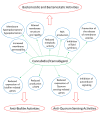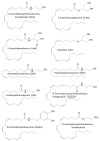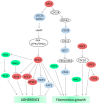Anti-Microbial Activity of Phytocannabinoids and Endocannabinoids in the Light of Their Physiological and Pathophysiological Roles
- PMID: 35327432
- PMCID: PMC8945038
- DOI: 10.3390/biomedicines10030631
Anti-Microbial Activity of Phytocannabinoids and Endocannabinoids in the Light of Their Physiological and Pathophysiological Roles
Abstract
Antibiotic resistance has become an increasing challenge in the treatment of various infectious diseases, especially those associated with biofilm formation on biotic and abiotic materials. There is an urgent need for new treatment protocols that can also target biofilm-embedded bacteria. Many secondary metabolites of plants possess anti-bacterial activities, and especially the phytocannabinoids of the Cannabis sativa L. varieties have reached a renaissance and attracted much attention for their anti-microbial and anti-biofilm activities at concentrations below the cytotoxic threshold on normal mammalian cells. Accordingly, many synthetic cannabinoids have been designed with the intention to increase the specificity and selectivity of the compounds. The structurally unrelated endocannabinoids have also been found to have anti-microbial and anti-biofilm activities. Recent data suggest for a mutual communication between the endocannabinoid system and the gut microbiota. The present review focuses on the anti-microbial activities of phytocannabinoids and endocannabinoids integrated with some selected issues of their many physiological and pharmacological activities.
Keywords: Cannabis sativa L.; anti-biofilm activity; anti-microbial activity; endocannabinoids; gut microbiota; pathogens; phytocannabinoids.
Conflict of interest statement
The authors declare no conflict of interest.
Figures





Similar articles
-
Cancer Initiation, Progression and Resistance: Are Phytocannabinoids from Cannabis sativa L. Promising Compounds?Molecules. 2021 May 2;26(9):2668. doi: 10.3390/molecules26092668. Molecules. 2021. PMID: 34063214 Free PMC article. Review.
-
Cannabis Biomolecule Effects on Cancer Cells and Cancer Stem Cells: Cytotoxic, Anti-Proliferative, and Anti-Migratory Activities.Biomolecules. 2022 Mar 24;12(4):491. doi: 10.3390/biom12040491. Biomolecules. 2022. PMID: 35454080 Free PMC article. Review.
-
Cannabinoidomics - An analytical approach to understand the effect of medical Cannabis treatment on the endocannabinoid metabolome.Talanta. 2020 Nov 1;219:121336. doi: 10.1016/j.talanta.2020.121336. Epub 2020 Jul 10. Talanta. 2020. PMID: 32887067
-
Recent advances in the chromatographic analysis of endocannabinoids and phytocannabinoids in biological samples.J Chromatogr A. 2024 Sep 13;1732:465225. doi: 10.1016/j.chroma.2024.465225. Epub 2024 Aug 2. J Chromatogr A. 2024. PMID: 39128236 Review.
-
From Phytocannabinoids to Cannabinoid Receptors and Endocannabinoids: Pleiotropic Physiological and Pathological Roles Through Complex Pharmacology.Physiol Rev. 2016 Oct;96(4):1593-659. doi: 10.1152/physrev.00002.2016. Physiol Rev. 2016. PMID: 27630175 Review.
Cited by
-
Harnessing Cannabis sativa Oil for Enhanced Skin Wound Healing: The Role of Reactive Oxygen Species Regulation.Pharmaceutics. 2024 Sep 30;16(10):1277. doi: 10.3390/pharmaceutics16101277. Pharmaceutics. 2024. PMID: 39458608 Free PMC article. Review.
-
Improved Anti-Biofilm Effect against the Oral Cariogenic Streptococcus mutans by Combined Triclosan/CBD Treatment.Biomedicines. 2023 Feb 10;11(2):521. doi: 10.3390/biomedicines11020521. Biomedicines. 2023. PMID: 36831057 Free PMC article.
-
Special Issue: Therapeutic Potential for Cannabis and Cannabinoids.Biomedicines. 2023 Mar 14;11(3):902. doi: 10.3390/biomedicines11030902. Biomedicines. 2023. PMID: 36979881 Free PMC article.
-
Anti-Bacterial Effect of Cannabidiol against the Cariogenic Streptococcus mutans Bacterium: An In Vitro Study.Int J Mol Sci. 2022 Dec 14;23(24):15878. doi: 10.3390/ijms232415878. Int J Mol Sci. 2022. PMID: 36555519 Free PMC article.
-
Potential Combinatory Effect of Cannabidiol and Triclosan Incorporated into Sustained Release Delivery System against Oral Candidiasis.Pharmaceutics. 2022 Aug 3;14(8):1624. doi: 10.3390/pharmaceutics14081624. Pharmaceutics. 2022. PMID: 36015249 Free PMC article.
References
-
- Bidlack W.R., Omaye S.T., Meskin M.S., Topham D.K. Phytochemicals as Bioactive Agents. CRC Press; Boca Raton, FL, USA: 2000.
-
- Ross I.A. Medicinal Plants of the World, Volumes 3: Chemical Constituents, Traditional and Modern Medicinal Uses. Volume 3 Springer Science & Business Media; Berlin/Heidelberg, Germany: 2007.
-
- Radulović N.S., Blagojević P.D., Stojanović-Radić Z.Z., Stojanović N.M. Antimicrobial plant metabolites: Structural diversity and mechanism of action. Curr. Med. Chem. 2013;20:932–952. - PubMed
Publication types
LinkOut - more resources
Full Text Sources
Molecular Biology Databases

